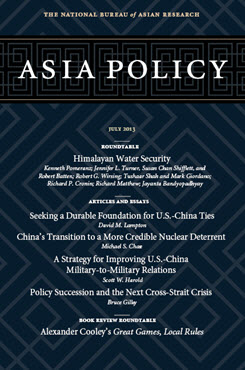Hydropower Dams on the Mekong
Old Dreams, New Dangers
This is one of seven essays in the roundtable “Himalayan Water Security: The Challenges for South and Southeast Asia.”
Today, the Mekong River Basin is on the edge of a two-pronged calamity as a result of both the long-term and near-term actions of humans and governments. Of the two, short-term actions such as deforestation, the unsustainable consumption of groundwater, and the construction of large silt-trapping dams are having a far more immediate impact than global warming, sea-level rise, and the greater frequency of violent weather events. These near-term actions of governments—especially the construction of massive cascades of large dams on the Mekong mainstream and major tributaries—are accelerating and magnifying the now inevitable long-term effects of global warming and climate change, especially sea-level rise.
The current threat to the life-giving ecology of the world’s most productive freshwater fishery stems from long-standing dreams of exploiting the river’s valuable forests, minerals, rich alluvial deposits, and hydropower potential as a basis for economic development and industrialization. Because of the unavoidable trade-offs among energy, food security (fishing and agriculture), and other uses of water, these dreams may be not only unattainable without a cooperative, basin-wide approach but also a significant source of danger to regional peace and stability.
As part of its multibillion-dollar “go west” development program, China has set its course to fully exploit the huge hydropower potential of the upper Mekong River, which it calls the Lancang, without any consideration for the interests and concerns of its downstream neighbors. Beijing regards the upper Mekong as its national river and treats information on development plans, operational matters, and even the level of its reservoirs as national security secrets.
The downstream impact of China’s dams in Yunnan Province on the lower, Southeast Asian half of the river can hardly be overestimated. Despite the recently accelerating pace of GDP growth throughout the river basin, tens of millions of people, mainly in Thailand, Cambodia, and Vietnam’s Mekong Delta, still depend on the river’s natural bounty for much of their food and livelihoods. The reservoirs of China’s Yunnan dams, two of which are among the world’s largest, together have the capacity to store at least half the average annual discharge of the upper Mekong. In addition to significantly changing the river’s hydrology, the dam cascade will trap an estimated 80% of the historical load of nutrient-rich silt flowing from China, thereby reducing the fertility of the soil downstream and contributing to the intrusion of seawater into the Mekong Delta. [1]
Although the governments of the most vulnerable lower Mekong countries are increasingly aware of the threat posed by China’s Yunnan cascade, they have yet to show the political will to curb even their own mismanagement of water, let alone make a serious effort to influence Beijing. Vietnam has long been constructing large dams on major tributaries of the Mekong in the Central Highlands. Cambodia is allowing the rampant destruction of its forests for dams and plantation agriculture. The Mekong Basin countries’ equities in terms of trade, investment, and infrastructure loans are such that they are reluctant to openly challenge Beijing, especially when different levels of the Chinese government have made clear that downstream criticism will not deter China from pursuing its goals.
Revived Plans for Dams on the Lower Mekong
Even more consequential than the impact of the Chinese dams on the river’s flow and sediment loads, the massive water storage capacity behind two of the dams (Xiaowan and Nuozhadu) has enabled the revival of a plan dating from the Cold War era for damming the lower Mekong. Nine of the dams would be constructed by commercial developers on the Lao (seven) and Lao-Thai (two) stretches of the mainstream, with two more in Cambodia. All but one of the planned dams would be large, ranging from 38 to 68 meters high, but with comparatively small reservoir storage capacity. The dams will decimate hundreds of species of fish consumed as food that migrate long distances to spawn and will trap additional silt from the already reduced flow from China.
Building the lower Mekong dams will also create a new and potentially very costly dependency on Beijing. Unless China releases enough water in the dry season, most, if not all, of the proposed dams would not be able to generate power during the driest months of the year. In light of China’s growing water crisis and the impact of climate change, it is not out of the…
[1] International Centre for Environmental Management (ICEM), “Strategic Environmental Assessment of Hydropower on the Mekong Mainstream: Final Report,” October 2010, 69, http://www.mrcmekong.org/about-the-mrc/programmes/initiative-on-sustainable-hydropower/strategic-environmental-assessment-of-mainstream-dams.
About Asia Policy
Asia Policy is a peer-reviewed scholarly journal presenting policy-relevant academic research on the Asia-Pacific that draws clear and concise conclusions useful to today’s policymakers. Asia Policy is published quarterly in January, April, July, and October and accepts submissions on a rolling basis. Learn more


